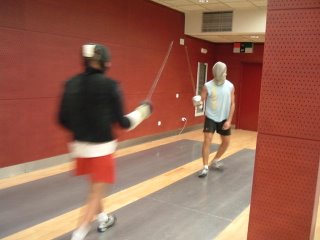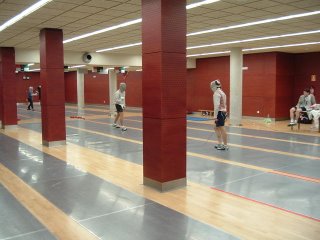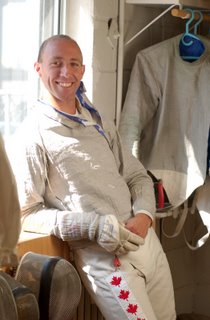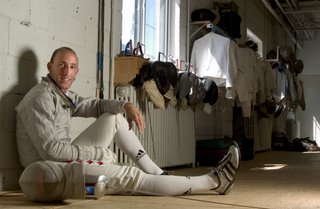The rest of the week was much of the same. BUT, who would go all the way to Spain and not take in the night-life? Dinner tended to be served later than usual....I guess later than what we are used to here in Canada. The first course of appetizers wouldn't hit the table until roughly 10:30pm, when the restaurants would start to fill up. We would finally finish the five course meal at midnight with a digestive alcoholic liquer called Rojo (I hope I spelt that right). Served right from the freezer, I was amazed how good it made me feel after such large serving of beef and sausages.
Mark Peros: Diary of a Fencer
Tuesday, August 29, 2006


Sunday, we traveled to the very historic town of Toledo. Holy Toledo!!! Famous for making swords and daggers, the city is engulfed by a castle wall atop a hill. Only 30min outside of Madrid by train, it has become a very popular spot for travellers and tourists...nearly hostels on ever corner. Winding little cobble stone streets, a massive church that was the most ornate I've ever seen, and quaint cafes that pop out through stone walls make for a lovely and relaxing afternoon in the sun.

Training usually started at 930am and went to 1230pm. Most of the morning was spent doing physical excercise, footwork, then fun and childish games of football to lighten up the atmosphere. From 2-5pm the city would shut down for the all famous siesta. I never realized they took it so seriously that we couldn't even get a sandwich made, it was that important to them. So we just ended up sitting by the pool of our hotel, sipping "agua con gaz", sunning our aching bodies and taking in all the female sites...I mean who wouldn't? Training would then start again at 5pm. This was the time to get in as much sparring as you could in the three hours. Bout after bout, even if you hadn't any gas left in the tank, it was the reason why we were there....international experience is what improves a fencer. During this session we would also take lessons....here I am taking a lesson with National Team Coach Jean-Marie Banos of Montreal. Look ma, no jacket!!!
Madrid Training Camp

So the squad just returned from a twelve day training camp held in Spain last week. My first time to Madrid was an amazing experience. The Spanish are probably some of the more social on the International Circut so we always enjoy spending time with them. Their National Training Centre is host to all their National Teams so its great to see so many athletes all in one place. The fencing salle, a room totally dedicated to fencing was a treat to use. Pistes and electric reels sunk into the floor so that their are no wires to trip over, and scoring boxes hung from the ceiling so that everyone can have a good look. Here I am finishing a bout with Pierre-Philip (my Canadian counter-part) at a late night practice.
Monday, August 28, 2006
Format and Schedules


The 2006-07 season starts in September with three National competitons that are referred to as Elite tournaments, or CSC's. These tournaments are limited to the top 48 fencers in Canada and are worth the most in National Level points. The International season begins in January of 2007. Six Grande Prix events have been selected by the FIE (International Fencing Federation) which take place on three continents during the following six months. Grande Prix events are the toughest of all International tournaments, hence they count for double the International points which ultimately is how a fencer is ranked.
This year is known as the pre-Olympic season and most points are rolled over to the following season (which is cut short) due to the Olympics which are being held in Beijing in 2008. Qualifying for these games are typically very difficult and political with the selection being held to only 45 fencers including the three wild card spots. The FIE has always been struggling with making this a truly International field as most of the top ranked fencers in the world come from Europe. So, it goes by Zones, which are basically the continents. Eight Teams of four fencers are selected to compete plus the top two fencers ranked the highest per zone.
There are six of us in Canada...(known as the "Squad") who travel the world representing this fine country of ours. Four from Montreal, one from Ottawa and one from Toronto...ME!!! But, only four can be selected, and that is the challenge ahead, my friends. Take a look at my National and International Schedule of competitions below....
Sept. 2-4 Montreal, QC - CSC #1
Sept. 20-25 Belfast, Ireland - Commonwealth Championships
Dec. 2-4 Richmond, BC - National Championships
Jan. 12-13 Tehran, Iran - Grande Prix #1
Feb. 2-3 Athens, Greece - Grande Prix #2
Mar. 2-3 Sofia, Bulgaria - Grande Prix #3
May 16-20 Montreal, QC - CSC #2
May 25-26 Madrid, Spain - Grande Prix #4
June 1-2 Pardou, Italy - Grande Prix #5
July 20-21 Las Vegas, USA - Grande Prix #6
With two back to back tournaments (Grande Prix #4 and #5) and a break in the month of April the plan as of now for me is to live and train in Madrid with the Spanish team for about a month before. Arrangements can easily be made since I have become good friends with the Spaniards who have welcome my stay already. I will be tracking and telling stories from each of these tournaments, so make sure you tune in! Traveling by far is a major plus of this sport. That's why I enjoy it so much.
Fencing: A Modern Sport

The sport of fencing is fast and athletic, a far cry from the choreographed bouts you see on film or stage. Two fencers perform this intense match together on a 6-feet by 44-feet strip of copper as touches are scored electrically because the movement is too fast to track by the human eye.
Competitors win a fencing bout by being the first to score 15 points against their opponent. Each time a fencer lands a valid hit - a touch - they receive one point. We are penalized for crossing the lateral bondaries of the strip while retreating off the rear of our side results in a touch awarded to the opponent.
Sabre is my weapon of choice. Hack and Slash is more like it in our lingo - as the sabre is the modern version of the cavalry sword. The major difference between sabre and the other two weapons, Foil and Epee, is that saberists can score with the edge of their blade as well as the point. The target area is the entire body above the waist, excluding the hands. In addition, sabre employs rules of "right-of-way" which means the fencer who starts to attack first is given priority: should his opponent counter-attack. However, sabre referees are much less forgiving of hesitation by an attacker. It is common to see a saber fencer execute a stop cut against their opponent's forearm during such a moment of hesitation, winning "right-of-way" and the point.
A mere graze by the blade against the lame (the outer electric jacket) registers a touch with the scoring machine. Under these circumstances naturally make saber a fast, furious, aggressive game, with fencers rushing their opponent from the moment the referee gives the "aller". In fact, a lopsided sabre match can literally be over in seconds. As fending off the attack of a skilled opponent is nearly impossible, the defensive is much harder than it looks. However, when forced to, we often go all-out using spectacular tactical and athletic combinations that make the crowd hold their breath.
Great! Now you have a brief explanation of the sport and a couple of the rules. Of course, I couldn't go through everything because it can get pretty detailed, but you can always just ask me questions if you feel the need. I would love to answer the best I can so that everyone gets more familiar with the sport.
